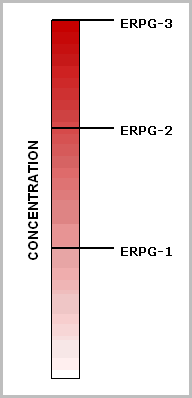Emergency Response Planning Guidelines (ERPGs)
ERPGs are exposure guidelines designed to anticipate health effects from exposure to certain airborne chemical concentrations.
What are ERPGs?

ERPGs estimate the concentrations at which most people will begin to experience health effects if they are exposed to a hazardous airborne chemical for 1 hour. (Sensitive members of the public—such as old, sick, or very young people—aren't covered by these guidelines and they may experience adverse effects at concentrations below the ERPG values.) A chemical may have up to three ERPG values, each of which corresponds to a specific tier of health effects. The three ERPG tiers are defined as follows:
- ERPG-3 is the maximum airborne concentration below which nearly all individuals could be exposed for up to 1 hour without experiencing or developing life-threatening health effects.
- ERPG-2 is the maximum airborne concentration below which nearly all individuals could be exposed for up to 1 hour without experiencing or developing irreversible or other serious health effects or symptoms which could impair an individual's ability to take protective action.
- ERPG-1 is the maximum airborne concentration below which nearly all individuals could be exposed for up to 1 hour without experiencing more than mild, transient adverse health effects or without perceiving a clearly defined objectionable odor.
How are ERPGs chosen?
ERPGs are developed by the Emergency Response Planning committee of the American Industrial Hygiene Association. The ERPG guidelines are clearly defined and based on extensive, current data. The rationale for selecting each value is explained, and other pertinent information is also provided. Each guideline identifies the substance, its chemical and structural properties, animal toxicology data, human experience, existing exposure guidelines, the rationale behind the selected value, and a list of references. To find out more about the ERPG development process, go to the ERPG Program website.
What substances have ERPGs?
About 150 chemicals have ERPGs; you can see the full set of ERPGs in the annual ERPG/WEEL Handbook published by the American Industrial Hygiene Association. You can also search for a specific substance on the CAMEO Chemicals site to find response recommendations and chemical data (including ERPGs).
How should ERPGs be used?
ERPGs should be used to help protect the public when AEGLs aren't available and there has been a chemical release that is short-term in duration. ERPGs estimate how nearly all of the public (except for sensitive individuals) would react to a release of this nature, so they can be used to identify areas where a hazard exists if the concentration of hazardous gas is exceeded for the specified exposure duration. For example, in areas with concentrations just above the ERPG-1, most people would experience temporary, non-disabling effects. On the other hand, in areas with concentrations just above the ERPG-2, most people would experience significant—but not life-threatening—health effects. These guidelines are focused on one period of time: 1 hour. Exposure in the field may be longer or shorter. However, the American Industrial Hygiene Association strongly advises against trying to extrapolate ERPG values to longer periods of time.
ERPGs shouldn't be used as:
- Guidelines for workers who are routinely exposed to chemicals for longer durations. In such cases, you should use workplace exposure limits, because they contain safety factors specific to that type of exposure.
- Guidelines for members of the public who are exposed to background chemical releases for longer durations. In these types of air quality issues, values such as the National Ambient Air Quality Standards (NAAQS) should be used rather than emergency response guidelines.
How does ALOHA use ERPGs?
In ALOHA, you can choose ERPGs as your toxic Levels of Concern (LOCs) when modeling a toxic chemical release—if ERPGs have been defined for that chemical. ALOHA allows you to specify up to three toxic LOCs. So, you can choose the ERPG-1, ERPG-2, and ERPG-3 values to generate a threat zone estimate where yellow, orange, and red zones indicate areas where those values were predicted to be exceeded at some point after the chemical release began. (To determine how long the LOC was exceeded at a particular location, read the Ask Dr. ALOHA article on working with the concentration graph.) For chemicals defined under the ERPG classification system, ALOHA will provide the ERPG values as the default toxic LOCs until AEGL values are established.
 An official website of the United States government.
An official website of the United States government. 